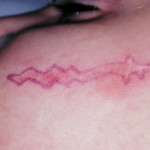
Scar excision (revision) is appropriate for scars that are wide, raised, depressed, or are a relatively straight line that crosses the relaxed skin tension lines (RSTL) of the face. (RSTLs are the natural cleavage lines of one’s skin that become quite evident when we get old……as wrinkles and folds….scars that lie parallel to the RSTLs will stay narrower and are less noticeable than those that cross it at angles or run perpendicular to them) No amount of time or any other form of scar treatment will make a scar narrower or make its edges flush with the surrounding skin. When a scar is cut out, it can be put back together in numerous geometric ways….depending upon what scar configuration will look better.
If putting the scar back together allows it to lie in a straight line parallelling a RSTL (for example, a horizontal orientation in the forehead or part of a circular pattern around an arm or leg), then a simple straight line closure would be most favorable. If, however, closing the scar makes a line that runs at angles to the RSTL…then a more geometric scar closure pattern may be used.
Geometric scar revision is based on a simple visual concept…..the eye has a harder time following an irregular line than a straight one. If the cutout of the scar and the way it is put back together creates an irregular pattern, then the scar may ultimately be less noticeable. These geometic scar patterns can be done as running Ws (like the pattern created by pinking shears), intermittent Ms, or a variety of other configurations. This type of scar revision is known as a broken-line closure or pattern. The most well-known geometric scar revision is the Z-plasty. Creating a Z along the line of a scar is the ultimate use of geometry. Z-plasties are most commonly used in scars that cross a moving surface (and have created a tight band or scar contracture) such as a joint or when the scar lies directly perpendicular a RSTL on the face. Skin flaps are cut around the skin crease or RSTL and the limbs of the scar flaps interposed. (criss-crossed) A Z scar is subsequently created but, equally important, the scar is actually lengthened across this area. Mathematically, the angle of the skin flaps that are cut determines how much scar length is actually gained. This technique is particularly valuable in the release of scar bands as reorientation and extra length is usally needed so that they do not recur after scar revision.
Geometric and broken-pattern scar revisions are an essential technique for improving many types of scars. These scar revision techniques require a good dose of time after surgery to see their benefits.
Dr Barry Eppley
Indianapolis, Indiana


